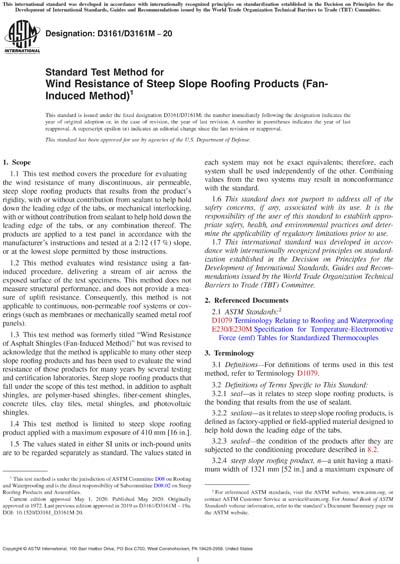Most recent
ASTM D3161/D3161M-20
Standard Test Method for Wind Resistance of Steep Slope Roofing Products (Fan-Induced Method)
1.1 This test method covers the procedure for evaluating the wind resistance of many discontinuous, air permeable, steep slope roofing products that results from the product's rigidity, with or without contribution from sealant to help hold down the leading edge of the tabs, or mechanical interlocking, with or without contribution from sealant to help hold down the leading edge of the tabs, or any combination thereof. The products are applied to a test panel in accordance with the manufacturer’s instructions and tested at a 2:12 (17 %) slope, or at the lowest slope permitted by those instructions.
1.2 This method evaluates wind resistance using a fan-induced procedure, delivering a stream of air across the exposed surface of the test specimens. This method does not measure structural performance, and does not provide a measure of uplift resistance. Consequently, this method is not applicable to continuous, non-permeable roof systems or coverings (such as membranes or mechanically seamed metal roof panels).
1.3 This test method was formerly titled “Wind Resistance of Asphalt Shingles (Fan-Induced Method)” but was revised to acknowledge that the method is applicable to many other steep slope roofing products and has been used to evaluate the wind resistance of those products for many years by several testing and certification laboratories. Steep slope roofing products that fall under the scope of this test method, in addition to asphalt shingles, are polymer-based shingles, fiber-cement shingles, concrete tiles, clay tiles, metal shingles, and photovoltaic shingles.
1.4 This test method is limited to steep slope roofing product applied with a maximum exposure of 410 mm [16 in.].
1.5 The values stated in either SI units or inch-pound units are to be regarded separately as standard. The values stated in each system may not be exact equivalents; therefore, each system shall be used independently of the other. Combining values from the two systems may result in nonconformance with the standard.
1.6 This standard does not purport to address all of the safety concerns, if any, associated with its use. It is the responsibility of the user of this standard to establish appropriate safety, health, and environmental practices and determine the applicability of regulatory limitations prior to use.
1.7 This international standard was developed in accordance with internationally recognized principles on standardization established in the Decision on Principles for the Development of International Standards, Guides and Recommendations issued by the World Trade Organization Technical Barriers to Trade (TBT) Committee.
ASTM International [astm]

